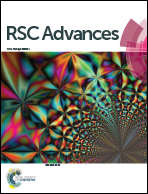Significant roughness enhancement of fluorine-doped tin oxide films with low resistivity and high transparency by using HNO3 addition
Abstract
Current development of fluorine-doped tin oxide (FTO) films for application in solar cells is limited by tradeoffs among surface roughness related light trapping, optical transparency and electrical conductivity. Proposed methods for improving the surface roughness are usually dependent upon thickness increment or sacrificing the conductivity. In this study, we report a simple method for preparing FTO films with a flower-like grain morphology and thus a higher than ever mean roughness of 51.4–73.3 nm or mean-root-square roughness of 70.5–91 nm, by inclusion of HNO3 additive into the deposition system. The very rough films are 200–300 nm thick and also have maintained a high transparency of 80–85% in the visible region and a low sheet resistance of 14 Ω □−1 and resistivity of 4.2 × 10−4 Ω cm, perhaps resulting from the effects of HNO3 on heterogeneous nucleation and development of the (200) preferred orientation. The high roughness, combined with high transparency and low resistivity, would be beneficial to improving the light trapping of FTO films and thus the efficiency of solar cells.


 Please wait while we load your content...
Please wait while we load your content...